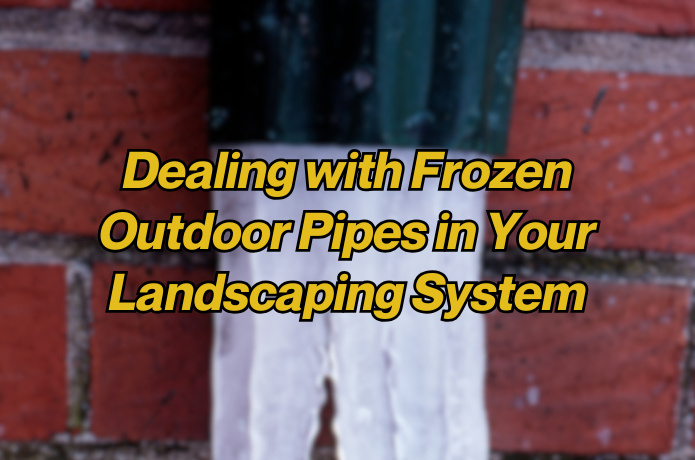Dealing with Frozen Outdoor Pipes in Your Landscaping System
Dealing with Frozen Outdoor Pipes in Your Landscaping System

Frozen pipes in your outdoor landscaping system can be a major issue during cold weather, leading to damage and costly repairs. Understanding how to prevent and manage frozen pipes is essential for homeowners who want to maintain their outdoor water system and protect their landscaping investment. If you live in an area that experiences freezing temperatures, the risk of your pipes freezing becomes a real concern. Water can freeze inside pipes, causing them to crack or burst, which can disrupt your irrigation and drainage systems.
Preventing frozen pipes starts with knowing where they are located and taking steps to insulate or protect them. By learning how to manage frozen pipes properly, you can avoid serious damage and keep your landscaping system functioning smoothly. In this article, we’ll discuss practical steps to prevent frozen pipes, how to thaw them safely, and what to do if they burst. Whether you are preparing for winter or already dealing with frozen pipes, these tips can help you protect your outdoor water lines and avoid the stress of expensive repairs.
Why Frozen Pipes Are a Concern in Your Landscaping System
Frozen pipes are a common problem in areas with winter temperatures below freezing. When water inside the pipes freezes, it expands, creating pressure that can cause the pipe to burst. This can be particularly problematic for outdoor landscaping systems such as irrigation lines, sprinkler systems, and drainage pipes. A burst pipe can lead to flooding, water damage, and expensive repairs. Moreover, if the water supply is compromised, your irrigation system will stop working, which can result in your plants and lawn suffering from a lack of water.
The risk of frozen pipes is heightened when outdoor plumbing is not properly insulated or protected. Even a small crack in the pipe can lead to significant damage if water continues to flow through it. That’s why it’s essential to take the necessary precautions to prevent freezing and ensure your landscaping system remains in good working condition during the colder months.
How to Prevent Frozen Pipes in Your Landscaping System
The best way to avoid dealing with frozen pipes is by taking steps to prevent them from freezing in the first place. One of the most effective ways to protect your outdoor pipes is by insulating them. Insulation helps keep the temperature of the pipes above freezing, even in the coldest weather. You can purchase pipe insulation sleeves at most home improvement stores, which are easy to install and offer good protection against the cold.
Another preventive measure is to drain your outdoor pipes before the cold weather hits. This is especially important for irrigation and sprinkler systems, as they can easily hold water in the pipes, which will freeze when the temperature drops. Drainage valves or manual drains can be used to clear water from the system, making it less likely for the pipes to freeze. If your landscaping system includes a pump, make sure to winterize it as well by draining all the water and storing it in a dry, warm location.
For areas where freezing is a regular concern, installing heating cables along your pipes is another option. These cables are designed to keep the pipes warm, even during freezing temperatures. They are an excellent investment for areas that frequently experience harsh winters. Make sure to follow the manufacturer's instructions carefully when installing heating cables to avoid damaging your pipes.
Additionally, sealing any gaps or cracks in your outdoor walls or around your landscaping system is a good way to prevent cold air from reaching your pipes. Even small openings can allow cold drafts to freeze the water in your system. Check for gaps around outdoor spigots, faucets, and irrigation valves, and seal them using caulk or foam sealant.
What to Do If Your Outdoor Pipes Freeze
Despite your best efforts, frozen pipes can still happen. If you discover that your outdoor pipes are frozen, it’s important to act quickly to avoid further damage. The first step is to turn off the water supply to the affected pipe. This will prevent water from flowing into the pipe and causing it to burst once it thaws. If the frozen section is part of a larger system, it’s best to shut off the main water supply.
Next, begin thawing the pipes carefully. The most effective way to thaw a frozen pipe is to use a heat source, such as a hairdryer, heat lamp, or space heater. Start applying heat to the section of the pipe closest to the faucet and work your way back. Never use an open flame or excessive heat, as this could cause the pipe to crack. It’s important to thaw the pipe gradually to avoid further damage. If you are unable to thaw the pipe yourself or are unsure about how to proceed, it’s a good idea to call a professional plumber.
In some cases, you may notice that a pipe has already burst. If this happens, it’s critical to turn off the water supply immediately to prevent flooding. Once the water has been turned off, inspect the area around the burst pipe for signs of water damage. If the damage is extensive, contact a plumber or professional to repair the pipe and assess any water damage to your landscaping system.
Steps to Take After Thawing Frozen Pipes
After thawing your frozen pipes, you should inspect the pipes for any signs of damage. Cracks, leaks, or bulges in the pipe may indicate that the pipe has been compromised and needs to be repaired or replaced. Even small cracks can lead to future problems, so it’s essential to address them as soon as possible.
Once the pipes have been inspected and any damage has been repaired, it’s important to take steps to prevent future freezing. Ensure that your pipes are properly insulated and that your outdoor system is prepared for the cold weather. If you haven’t already, consider installing heating cables and draining your pipes before the next freeze.
Frozen outdoor pipes can be a serious problem, especially for landscaping systems that rely on consistent water flow. By taking steps to prevent freezing, such as insulating pipes and draining irrigation systems, you can protect your landscaping investment and avoid costly repairs. If your pipes do freeze, act quickly to thaw them safely and check for any signs of damage. By being proactive and prepared, you can keep your outdoor water system functioning smoothly throughout the winter months, ensuring that your landscaping thrives year-round.

